It’s fair to say that software-defined radio represents the most significant advance in affordable radio equipment that we have seen over the last decade or so. Moving signal processing from purpose-built analogue hardware into the realm of software has opened up so many exciting possibilities in terms of what can be done both with more traditional modes of radio communication and with newer ones made possible only by the new technology.
It’s also fair to say that radio enthusiasts seeking a high-performance SDR would also have to be prepared with a hefty bank balance, as some of the components required to deliver software defined radios have been rather expensive. Thus the budget end of the market has been the preserve of radios using the limited baseband bandwidth of an existing analogue interface such as a computer sound card, or of happy accidents in driver hacking such as the discovery that the cheap and now-ubiquitous RTL2832 chipset digital TV receivers could function as an SDR receiver. Transmitting has been, and still is, more expensive.
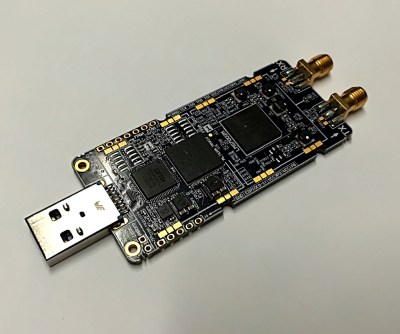
A new generation of budget SDRs, as typified by today’s subject the LimeSDR Mini, have brought down the price of transmitting. This is the latest addition to the LimeSDR range of products, an SDR transceiver and FPGA development board in a USB stick format that uses the same Lime Microsystems LMS7002M at its heart as the existing LimeSDR USB, but with a lower specification. Chief among the changes are that there is only one receive and one transmit channel to the USB’s two each, the bandwidth of 30.72 MHz is halved, and the lower-end frequency range jumps from 100 kHz to 10 MHz. The most interesting lower figure associated with the Mini though is its price, with the early birds snapping it up for $99 — half that of its predecessor. (It’s now available on Kickstarter for $139.)
We were lucky enough to be sent a pre-production LimeSDR Mini for review by the MyriadRF folks — in fact we were sent two of them, after the first one proved to have a hardware fault suspected to involve a solder joint issue. We feel their pain, after all who hasn’t had pre-production boards springing faults at inconvenient moments!
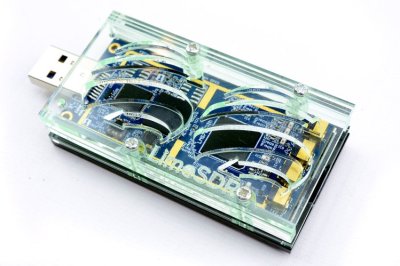
The board itself is a PCB about 33 mm x 70 mm (1,25 ” x 2.75 “), with a USB 3 plug at one end and a pair of SMA sockets at the other, one for receive and the other for transmit. The integrated circuits are all on the top of the board, and though they have included footprints screening cans, they are not populated. There is a single multicolor status LED between the SMA sockets. It’s worth mentioning that there will be a laser-cut plastic case for the board, which is probably worth getting as it feels somewhat vulnerable as it is. Along with as the board, they supplied a pair of little rubber duck antennas for the 870 MHz band.
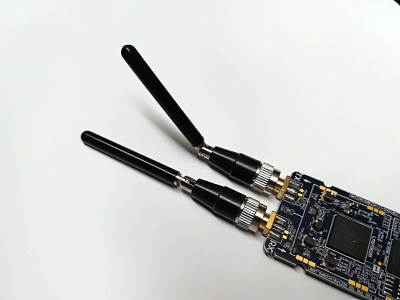
It is evident that the LimeSDR Mini is an extremely capable board that in the hands of a real expert in SDR and FPGA programming could have the potential for great things. It is also evident that as your Hackaday scribe I am not an SDR extreme power user. Despite holding an amateur radio licence for over three decades I have been a relative late comer to the world of SDRs, and have not progressed beyond RTL-SDRs or simple devices using a PC soundcard for baseband. But it’s probable that while many SDR programming experts will indeed buy this board, the majority of its customers will be similarly newcomers to the art. Therefore this review will be biased towards the SDR non-guru, the long-time radio enthusiast considering the LimeSDR Mini as a first transceiver.
The first task with any SDR will always be to install whatever software is required on the host machine. Here that means a copy of the latest Ubuntu distribution, but Windows and MacOS machines are also supported. There is a handy page of instructions, which in the case of Ubuntu require you to add a PPA repository for the drivers, then install the Lime Suite software and the SoapySDR abstraction layer. It is this final package that makes the LimeSDR an interesting prospect, by offloading software compatibility onto the widely used abstraction layer they hope to avoid some of the pain seen with other products.
Testing it Out
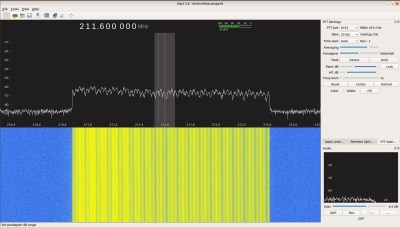
Once the drivers have been installed, it is time to decide which software to run first. The Lime Suite GUI supplied with the driver packages will be the first port of call to test the board, but I am told that the version in the PPA at the time of writing with the Mini not having been released is written with the LimeSDR USB in mind and therefore I should use GQRX. In the case of Ubuntu this can be installed through the graphical software installer, but as luck would have it I already had it on my machine. Selecting “other” as my SDR and pasting driver=lime,soapy=0 as my device string soon had the familiar interface in front of me, and with a suitable antenna in no time I was listening to my local BBC Radio 4 FM transmitter.
![A simple FM transmitter, derived from this example by [Gyaresu].](https://hackaday.com/wp-content/uploads/2018/02/fm-tx-gnu-radio.jpg?w=400)

To have a board like the Mini and simply use it for GQRX is to waste so much of its potential. We are promised a library of tailor-made applications via Snappy Ubuntu Core, but this isn’t yet available pre-release. Your next stop would then probably follow ours with GNU Radio, and in particular its drag-and-drop GUI application GNU Radio Companion. This is nuts-and-bolts homebrew radio for the SDR age, just as analogue radio amateur homebrewers would solder their own radios while others bought shiny transceivers, so the SDR homebrewer can build their own devices using GNU Radio. It’s a package that’s beyond the scope of this review, but as an example when playing with the Mini it was fairly easy to cobble together a little GNU Radio receiver to pull in and extract the signals from a 433 MHz remote control transmitter we have in the house, and then regurgitate them through a 433MHz Baofeng antenna for the satisfying sight of a table lamp at the other end of the bench turning itself on. The Mini itself doesn’t intrude into this process beyond simply doing what it’s told once its communication with GNU Radio has been achieved, so experimenting further into the mechanics of decoding the bitstream itself became a matter of working through a set of tutorials and burning the midnight oil. The steep learning curve is amply offset by the satisfaction of playing with the instant gratification of radio building blocks without the pain of reworking any intricate soldering.
In transmission terms the maximum 100 mW output power is fairly modest for anyone used to amateur radio. But given that many applications for this board will involve the likes of sniffing for and responding to more local devices rather than seeking contacts from other continents this is something likely only to trouble radio amateurs without the wherewithal for a power amplifier. The twin antenna connectors will be somewhat annoying if you are used to a single one on a simplex transceiver, unless you are transmitting and receiving on different frequencies, of course.
A review of an SDR over a short period can not hope to cover all its many capabilities, so this one has been an impression of the Mini as a platform for experimentation and learning about how to use an SDR transceiver. But in just the time that it has been on the bench here, the Mini has opened a significant new vista over an RTL-SDR, and given a few months in which to play with GNU Radio will I am sure provide both some useful radio applications and a seriously interesting learning process.
Previous SDRs at the budget end of the market such as the HackRF have all remained somewhat expensive purchases, ones a typical radio amateur might have had difficulty concealing from their partner in the family accounts. With a price point that is almost edging into the realm of an impulse purchase, the Mini has the potential to become an SDR transceiver for everyone. If you have been holding back because of the price, maybe it’s time you gave it a look.

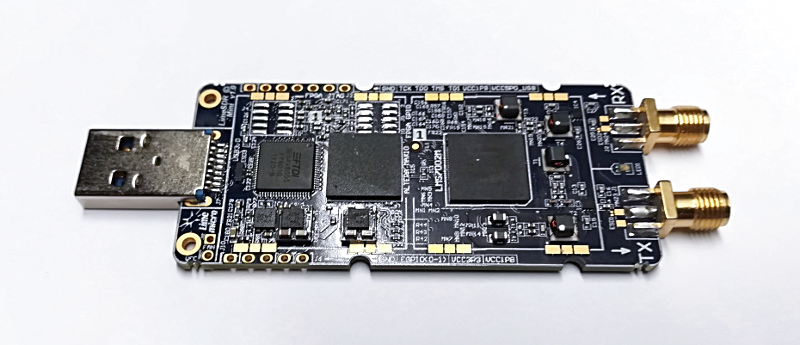













I don’t think the LimeSDR or LimeSDR-Mini is available on Kickstarter, but instead on Crowdsupply (https://www.crowdsupply.com/lime-micro/limesdr-mini). Its a great little radio, even if the drivers aren’t all ready yet for apps like SDRAngel or GQRX, but I’m sure it will in time.
thanks for the link, would this be overkill for someone just entering the world of SDR?
Well, SDR receivers are a lot cheaper than transceivers, one could go that route.
Well I came across the HackRF One a time back, this one seems way more affordable already. Do you know any proper transceivers for even less?
No, I don’t, but I’m not following SDR news closely…
We bought a LimeSDR kit for designing our own lab equipment, and discovered the full version can do things other platforms simply can’t perform. The micro lite version seems pointless given the negligible price difference, but it can still do full-duplex experiments unlike a HackRF. When you dig into the lime chip docs it shows some fairly cool features that you would have to traditionally add onto RF transceiver equipment (it saves about $30 per input), but you may have to note which front-end transformer specs you received to better match them for low frequency performance (we got ours from the second lot of boards).
Initially we had also looked at HackRF given its frequency range extends to 6GHz, but it would have taken 4 HackRF units to pull off what the full limeSDR module does in a single FPGA no less. Note LimeMicro is hinting there is an even better chip coming soon, so if you can stand to wait a year an even better setup may be available.
As an owner I’m constantly amazed a crowd funded project I bought into turned out so well this time… I chose the USB3 version so we can stick the entire shielded receiver front-end on a 18″ dish. The expensive antennas they bundle were crap, but the limeMicro itself is well worth the few bills. Note, if you do plan to enable broadcast modes, than a bandpass filter is still certainly recommended on any SDR output (Qucs seems ok for simple filter designs). Some have noted the output of the lime boards do not automatically tolerate loading very well, and although I haven’t personally seen this issue some units may require a 6dB attenuator (in-line SMA-RP filters are <$5) to reduce output distortion.
It would be overkill unless you already had a specific application in mind. You can get an RTL-SDR dongle for <$15. It's Rx only, but will give you a feel for SDR while being cheaper and easier to get started with. It can do quite a lot on the Rx side and will let you know whether or not you wanna upgrade to the LimeSDR or another.
I should have one laying around somewhere which I used to check for airplanes on 1090mhz when I was out with drones
There is a nice hilltop amp that can take 100mw in and put up to 30w out. The HF packer amp. Check it out,
@Cecil,
It would be nice if you INCLUDE a LINK when you call out a product. No? OK, I’ll do it for you here:
http://hfprojects.com/
Now, that’s done… Three things everyone else needs to know about the HF Projects stuff:
1. Be prepared to enable lots of useless scripting when you visit the HF Projects site to see the actual prices. (You DO use selective-static scripting in your browser right? If not, you are… Never mind.)
2. The prices of the HF Projects amps is HIGH! Be ready to shell-out significant amounts of money.
3. The HF Projects amplifiers are HF ONLY. Roughly through around 30MHz.
Amateur radio equipment doesn’t necessarily mean amateur prices. Sigh.
“Thus the budget end of the market has been the preserve of radios using the limited baseband bandwidth of an existing analogue interface such as a computer sound card, or of happy accidents in driver hacking such as the discovery that the cheap and now-ubiquitous RTL2832 chipset digital TV receivers could function as an SDR receiver. ”
There’s the use of cellular hardware if memory serves. Also making SDR hardware cheaper allows one to have more than one for those applications that work best with one.
Mine has the can over the RF board. Isn’t the power output 10mw? I’ve been looking for small amps on ebay that can make it useful for Ham radio applications. Unfortunately I haven’t had a chance to use it yet since I lacked the foresight to order sma antennas ahead of time. Oops.
There are a bunch of sub-GHZ broadband amps on ebay for around $20 that will get that output up to a watt or three. Be warned that they produce significant harmonics, so you’ll need some lowpass filters for each frequency range you want to use. Those aren’t too hard to build for cheap.
I went with the HackRF One. It seemed a more prudent investment as the software and userbase were larger. I have yet to properly use it. I see the potential but the learning curve with SDR is also quite steep.
I did the same. Figure when I want to move to higher bandwidth, higher dynamic range, faster sampling rates, lower noise floor and more options I can invest then. HackRF One seems like a great learning tool. Neat to see more options at an affordable price. I invested in heat sinks, the RF shield, aluminum case and some filters to be safe also. Seems interesting the repeater potential on just one system with the LimeSDR. I made a spreadsheet to compare and contrast the different SDR’s also and I still need to add a few including the USRP and HDSDR systems.
The link to the .xls file can help: https://drive.google.com/open?id=1Y27hmOXBn2sIjdW5bYES9bMpq2k5x1kE
Nice spreadsheet. Of particular interest to me – once you decide you want HF coverage, the number of candidates drops off quickly.
Thanks, the weathers cleared up outside so I need to work on the list of landscaping and home repair projects. I’ll try to update more as I gather info and format clearer. Feel free to reply with references if I miss anything.
I found the higher end older SDR systems (see sheet 2) seemed to be more HF where the newer systems are going into UHF and Microwaves as the trend. Also, don’t forget the concept of using old radios, spectrum analyzers, I think even oscilloscopes hacked a little (if one channel used with FFT math embedded or USB/Serial/GPIB on the computer on the digital scopes since the sampling rates and bandwidth aren’t bad if I understand correctly and noise isn’t more the issue) and up or down converted ISM systems with discrimination taps as a way to get more visual and tuning options. The later is more a tangent I think wasn’t my best decision… though I do need to learn to build my radio and electronics since that is what the elders did and I like to know how to.
I’ve seen a downconverter for a CB from the Ukraine on eBay for cheap and put in my watch list as I envision connecting to the CB radio station for broader coverage. The same can be done with upconverters. I have to get back to work.
I love these SDR boards. They keep getting smaller, more feature rich, and more better-er. I then head over to the buy page, but then I think, “wait, what would I actually do with this?” So let me ask SDR owners, what do you do with yours?
You can be part of the network of satellite groundstation : http://satnogs.org/
Multimode (AM, NBFM, SSB), multiband, full-duplex transceiver for the amateur radio bands (and then some, of course). Just add a suitable RF power amplifier and appropriate filtering. This would be great for an amateur satellite communications setup.
Hello Mac have you done any consulting on these?
how can they possible sell it and comply with FCC etc. regulations?
The transmit power is very low so it will be in compliance with FCC regulations for unlicensed use on ISM bands. Transmission outside of those bands require licensing or is prohibited. Then it is up to the user to make sure that they use the LimeSDR Mini in compliance with FCC regulations and are properly licensed to transmit on the frequencies chosen.
It is licensced as a laboratory tool, not a transceiver for use with any service.
Even at 10mW it exceeds FCC and CE harmonics suppression requirements easily.
So as said, it is entirely up to the end user to ensure they are in compliance.
Available on kickstarter huh? Do you guys even proofread your articles any more? The Lime Micro guys have been working with Crowd Supply for a long time.
“Do you guys even proofread your articles any more?”
Whoa! Do mean that at one time HaD proofread their articles?
When was that?
What are you talking about? Crowdfunding means Kickstarter, just like microcontroller means Arduino, single board computer means Raspberry Pi, and wearable electronics means LEDs on your shirt. Did you not get your HaD Dictionary?
As someone said the driver situation is in a bit of flux right now. I think one of the recent updates has broken a lot of stuff. I can only properly get mine to work with the Limesuite GUI. It has occasionally burst into life in cubicSDR and shown its potential. I suspect these issues will be resolved in days. They are shipping a large number of Lime-mini’s so suspect iit will get more application support fairly quickly.
I have a case on thingyverse if anyone needs it. Just search LimeSDR (mine is red)
That’s not true at all. Updates have only fixed bugs. The drivers are working as expected right now.
I can only go by my experience. I have tested 3 different computers under Linux and Windows. The LimeSDR-USB works on all of them. There is something wrong with how the clock PLLs are being configured(within Soapy I think)
The getting started guide is written for the bigger brother SDR which doesnt help.
Last night I finally got mine going. I even went as far as buying an PCIe USB3.0 card because I was doubting the motherboard’s USB 3.0. I now have the LimeSDR mini working on a Windows 10 Laptop as well as my Ubuntu desktop.
When you configure GQRX I had to use the following lines:
driver=lime,soapy=0
A sample rate of 15360000 S/s or 7680000 S/s. Attempting to use the 30720000 causes my PC to drop the USB device.
On the input control panel you then need to set the antenna to “LNA_W”.
With that done, I now see 15MHz of the FM spectrum.
I have tried that. How and when did you install the Soapy drivers and gqrx? Did you use the Pothosware build?
same question for you, have you done nay consulting
Given RX and TX are separate sockets, it would seem trivial to add switching relays and a PA of any power you require.
e.g. http://www.minikits.com.au/electronic-kits/rf-amplifiers/rf-high-power
For under AU$500 you’ve got a 60W SDR transceiver that’s capable of 30m-10m; 6m; 2m and 70cm.
Not forgetting 1.25m (220), 33cm (900), 23cm, etc. bands for which it is hard to find “appliances”. One could, with the appropriate FPGA logic and some supporting analog chips, turn one of these into a full-featured stand-alone radio.
Given that 1.25m and 33cm don’t exist as amateur radio bands here in Australia, it’s all too easy to forget about those bands. :-)
Any chance that the Australian version of the FCC can win them for y’all?
My wife and I visited Oz last year and loved it. Ayer’s rock, Cairns, and Sydney that time, but we’ll be back for more.
Exert your Rights and Lobby. Probably can like the liberals do in the U.S., i.e. other countries lobby for what they want here up to and including violating our Rights. We can help the Aussie’s out against tyranny too unless there is valid reasonable justification for why not to. Any ideas why not?
Errm… that’s Uluru… not Ayer’s rock. Ayer didn’t discover it, the Aborigines did. Specifically, it was certain tribes in the area now known as Alice Springs. ;-)
I think those bands are allocated elsewhere, and the ACMA is in the business of auctioning off spectrum for money, they are not a charity. Amateur radio very much takes a back seat where their policies are concerned, which is evident with the results of the 1kW transmitter trial, trials on 5MHz (60m) and the restrictions on the 50-52MHz for much of the east coast of Australia.
Anyone has problem with the PPA mentioned in the Wiki page? My Ubuntu box says “Cannot add PPA: ‘ppa:myriadrf/driver'”
The documentation used to recommend Ubuntu 16.04 LTS, and can be installed using:
add-apt-repository -y ppa:myriadrf/drivers
apt-get update
apt-get install libwxgtk3.0-dev freeglut3-dev
apt-get install git g++ cmake libsqlite3-dev
apt-get install libsoapysdr-dev libi2c-dev libusb-1.0-0-dev
apt-get install limesuite limesuite-udev
apt-get install soapysdr soapysdr-lms7
Let me know if it helps you out. =)
Thanks. It does help a lot. These commands work on my 16.04 box but not on my 14.04.
I can’t install soapysdr-lms7 though. It has this error:
soapysdr-lms7 : Depends: liblimesuite16.8-1 (= 16.8.1.819.792.4165104-myriadrf1~xenial) but it is not going to be installed
E: Unable to correct problems, you have held broken packages.
Both limesuit and liblimesuite-dev are at version (17.12.0-myriadrf~xenial).
If I ignore these errors, I see LimeSuitGui and LimeUtil found the LimeSDR, but SoapySDRUtil does not find it for some reasons. This definitely needs some learning curve.
Thanks
#packages were updated since my initial install last year… see current list below… =)
#Try listing your package settings to check if any are held at an old version:
dpkg –get-selections |grep -e “soapy\|lime”
liblimesuite17.12-1:amd64 install
libsoapyosmosdr0:amd64 install
libsoapysdr-dev install
libsoapysdr0.6:amd64 install
limesuite install
limesuite-images:amd64 install
limesuite-images17.12:amd64 install
limesuite-udev:amd64 install
soapysdr install
soapysdr-module-airspy install
soapysdr-module-bladerf install
soapysdr-module-hackrf install
soapysdr-module-lms7 install
soapysdr-module-mirisdr install
soapysdr-module-osmosdr install
soapysdr-module-redpitaya install
soapysdr-module-remote install
soapysdr-module-rfspace install
soapysdr-module-rtlsdr install
soapysdr-module-uhd install
soapysdr-modules-all install
#Check if your deb install itinerary is the same, then try a ppa based driver and gnuradio package update
apt-add-repository -y ppa:myriadrf/drivers
apt-add-repository -y ppa:myriadrf/gnuradio
apt-get update
apt-get upgrade
apt-get install limesuite limesuite-udev
apt-get install soapysdr soapysdr-lms7
#Also try the newer gqrx
add-apt-repository -y ppa:gqrx/gqrx-sdr
apt-get update
apt-get upgrade
apt-get install libvolk1-bin
volk_profile
#You will find most utilities will need the ppa versions, and gqrx may need some api parameter tweaks for some users
=)
try soapysdr-module-lms7
Thanks Joel, John for your help.
It turned out I had some old soapy library that I compiled from source some long time ago that prevent SoapySDRUtil from finding my LimeMini. On a fresh install Ubuntu, I got GQRX work fine.
I still have problem with setting up GQRX with the Soapy SDR that I compile from source though. Got a little error saying “FATAL: SoapySDR::Device::make() no match” when I launch gqrxx. Still digging.
Found the reason. My SoapySDR version was 0.7. From Joel’s instruction I noticed that Soapy lib was 0.6. Checkout Soapy 0.6 and recompiled Soapy and Lime, and GQRX is now working. Thanks guys. Time to start learning Pothos SDR and GNU radio I guess.
I really wish these guys would have a fast sweep function like the HackRF: https://discourse.myriadrf.org/t/fast-sweep-similar-to-hackrf-update/764/13
Having a fast spectrum analyzer for this price would be amazing <3
I know you can emulate this on the PC, but it's nowhere near the speed this feature offers, using that you can sweep the entire bandwidth in less than a second.
I’m a bit stumped on the build here on Ubuntu with GQRX. I’ve built on 16.04 and 17.01. Seems like it is almost there but GQRX never finds or displays the antenna connectors I’ve followed the directions here
https://wiki.myriadrf.org/Lime_Suite#Ubuntu_PPA
I haven’t built from source yet. I install GQRX from both the ubuntu ppa and from apt-get. My limesdr mini seems to work fine under lime suite and it works fine under the Windows Pothos build. I simply cannot get it working under Ubuntu. Any help appreciated.
The instruction Joel gave me seems working on a somewhat fresh installed Ubuntu 16.04
apt-add-repository -y ppa:myriadrf/drivers
apt-add-repository -y ppa:myriadrf/gnuradio
apt-get update
apt-get upgrade
apt-get install limesuite limesuite-udev
apt-get install soapysdr soapysdr-module-lms7
Then
http://gqrx.dk/download/install-ubuntu
I didn’t run the vox command.
I think you need to see if SoapySDRUtil –find able to find your LimeMini first before starting GQRX. Start gqrx from command line to see if you see any error reported.
Do I first have to connect to limesuite and change some clock settings or something before I can use with GQRX?
I didn’t have to set anything on LimeSuite to get the GQRX working. However when I was tumbling trying to get GQRX working, I did run the LimeSuite to upgrade the FPGA bitstream. Looking back now, I don’t think I would have needed to do so. But I’m not quite sure
I’ve not used the LimeSDR’s. Not sure if you’re able to connect to the SDR or like PLL issue or what exactly. Maybe some screen shots uploaded somewhere and referenced or the details more elaborately as to what the issue is clearly will help in troubleshooting. Guessing again where I’ve had PLL issues and also I’ve found that sampling rates will make a difference in regards to ability to hear audio in GQRX. I need to get back outside and rake and dig. Hope you get the system working.
I have easy capt and wintv USB for T. V. Is it anyway possible to convert it into sdr rtl. If yes pls mail me on chetnapatel2019@gmail com. Thanx
You can check out the a review of the best software-defined radios . Limesdr did not make it to the list on account of the limited community support relative to the other SDRs. This is an important factor – almost as important as hardware specifications.